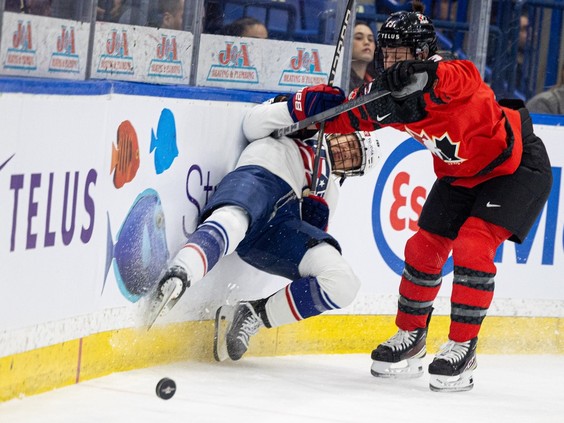
by Darren Zary
Saskatoon StarPhoenix
Should more contact be allowed in women’s hockey?
That is the question asked of players and coaches involved in the Canada-U.S. Rivalry Series.
While women’s hockey keeps evolving into more of a contact game, there’s still a bit of a disconnect between the Professional Women’s Hockey League and the international level, and how the game is officiated in each.
There appears to be a growing desire to adopt the PWHL style of game at the International Ice Hockey Federation level.
“I think the women, the coaches, the fans want to see that physical brand of hockey,” said Team Canada and PWHL Toronto head coach Troy Ryan.
“Right now, I think one of the things the league talked to us about is that, actually, they believe it’s being called the true meaning of the rule as opposed to maybe how it’s been called in the international game.
We want it to be physical. I think the players want it to be physical and I think the fans have voiced that opinion.”
Team Canada captain Marie-Philip Poulin, who is considered one of top female players in the world, is all aboard.
“One hundred per cent,” said Poulin. “I feel that when you play at the international level, there’s such a fine line. There are refs that let us play; there are others that don’t. Hopefully we’re going to learn from that and see that the PWHL is so exciting, to be able to play physical and fast. It’s been a great month and we just want to keep going.”
Forward Emily Clark, who is playing in her home province this week for Games 5 and 6 of the CAN-U.S. Rivalry Series, favours physicality.
“I would attest being from Saskatchewan for that grit I have in my game,” said Clark, who played contact youth hockey with boys with the Saskatoon Flyers in the Saskatoon Minor Hockey Association. “I love the physicality. I think it’s a big part of my game. I’ve been really enjoying it (PWHL). It will be interesting to see.”
When it comes to international play, where games have been officiated more strictly, everybody agrees there needs to be an adjustment by the players and coaches involved.
“There are a few different rules,” Clark said prior to the games this week. “A few different things make the PWHL a lot of fun and differentiates it from international. I think there’ll be an adjustment. Obviously, all of us have been playing quite physical hockey. The rules are different. It will be interesting. I think there’ll be kind of a learning curve for both teams, seeing how far we can push it.”
Team Canada coach Ryan agreed: “I think there’s going to be some adjustments for sure. I also know the international (IIHF) will look into the PWHL just like the PWHL looks into international hockey. Like anything, hopefully there’s more of a merger and they get some more consistent rules, for sure.”
Team U.S.A. coach John Wroblewski said he’s looking for a happy medium that won’t impede the speed of the game.
“It’d have to be a large balance of a lot of things coming into place,” said Wroblewski. “I believe hockey should be played organically in a physical nature, but I also would also think the skilled players need freedom to be able to do their thing.
“If you’re going to allow the physicality on the PW(HL) side, you’d better make sure the stick-work is out of the game and interference also has to be called extremely tight because, otherwise, you’re just going to have a slugfest and there are too many skilled players to inhibit, and I think that’s already a little bit of a space because of the lack of being able to call — interference is sort of an art form. Take it or leave it, but that slows down offence.”
dzary@postmedia.com

